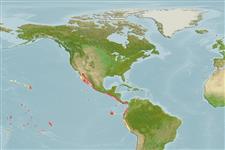Teleostei (teleosts) >
Lophiiformes (Anglerfishes) >
Antennariidae (Frogfishes)
Eponymy: Henry Weed Fowler (1878–1965) was an American herpetologist, ornithologist, ichthyologist and artist. [...] (Ref. 128868), visit book page.
More on authors: Jordan & Starks.
Environment: milieu / climate zone / depth range / distribution range
Ecology
Marine; demersal; depth range 0 - 300 m (Ref. 9269), usually 0 - 95 m (Ref. 9269). Subtropical; 34°N - 15°S
Eastern Pacific: Santa Catalina Island, southern California, USA to Peru.
Size / Weight / Age
Maturity: Lm ? range ? - ? cm
Max length : 33.0 cm TL male/unsexed; (Ref. 55763); common length : 15.0 cm TL male/unsexed; (Ref. 55763)
Adults inhabit rocky areas, including the intertidal zone. Found on sandy and muddy bottoms (Ref. 9269). Young individuals feed heavily on crustaceans but as they grow bigger, they consume more and more fish, sometimes catching and eating fishes their own size (Ref. 4930).
Life cycle and mating behavior
Maturity | Reproduction | Spawning | Eggs | Fecundity | Larvae
Eschmeyer, W.N., E.S. Herald and H. Hammann, 1983. A field guide to Pacific coast fishes of North America. Boston (MA, USA): Houghton Mifflin Company. xii+336 p. (Ref. 2850)
IUCN Red List Status (Ref. 130435: Version 2024-2)
Threat to humans
Harmless
Human uses
Tools
Special reports
Download XML
Internet sources
Estimates based on models
Preferred temperature (Ref.
123201): 15.7 - 28.8, mean 23.3 °C (based on 270 cells).
Phylogenetic diversity index (Ref.
82804): PD
50 = 0.5312 [Uniqueness, from 0.5 = low to 2.0 = high].
Bayesian length-weight: a=0.02630 (0.01029 - 0.06725), b=2.96 (2.73 - 3.19), in cm total length, based on LWR estimates for this (Sub)family-body shape (Ref.
93245).
Trophic level (Ref.
69278): 4.0 ±0.66 se; based on food items.
Resilience (Ref.
120179): High, minimum population doubling time less than 15 months (Fec assumed to be > 10,000).
Fishing Vulnerability (Ref.
59153): Low vulnerability (23 of 100).
